15 of the Most Important Bathroom Flooring Ideas You Need to Know When You're Planning a Makeover This Year
Style meets substance in these bathroom flooring picks, offering the perfect balance of durability, trend appeal, and everyday practicality
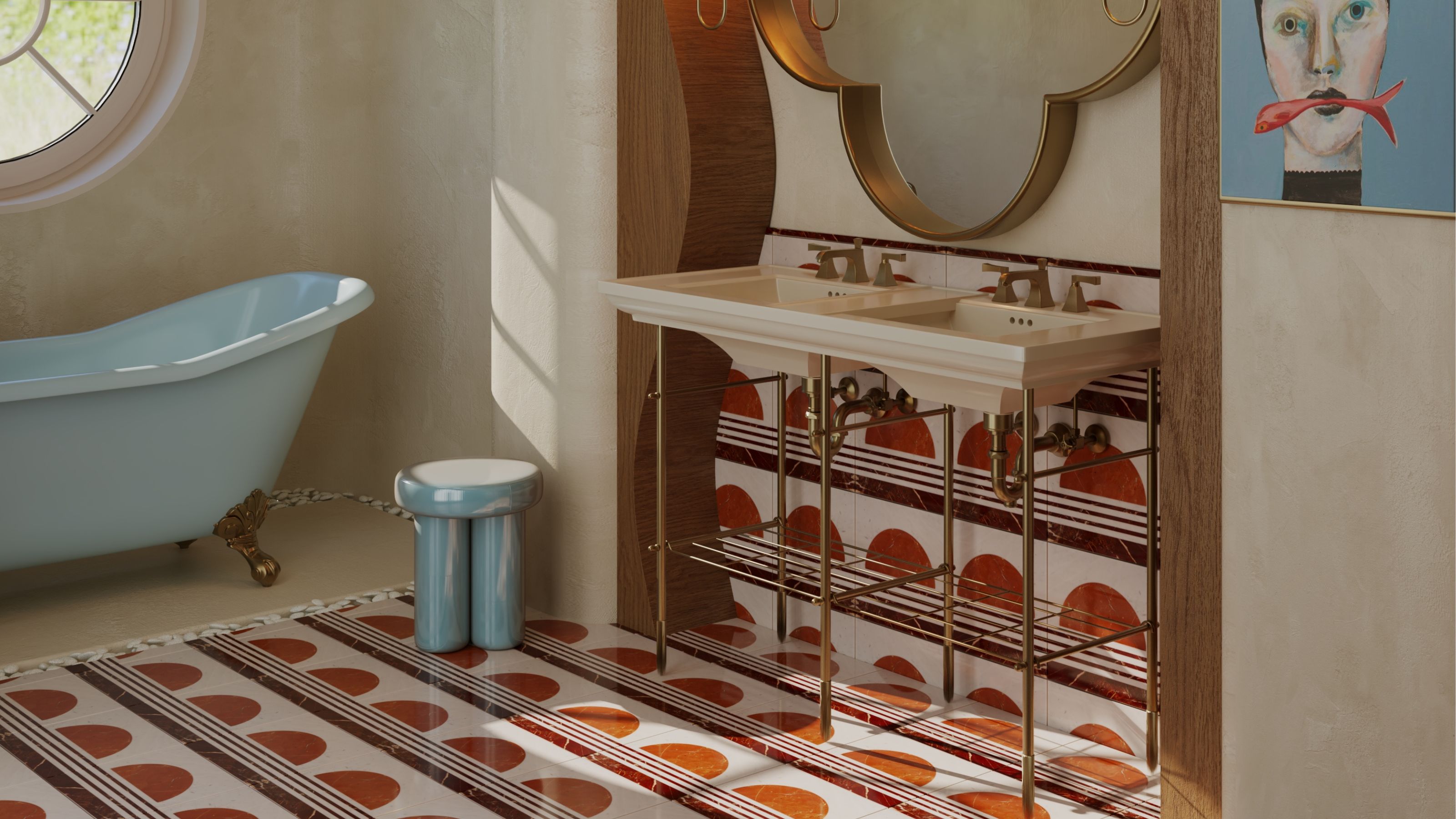

Start your bathroom design from the ground up — choosing the right flooring is essential, as this foundational element ensures the longevity and durability of the space.
It’s a hardworking surface that needs to handle moisture, feel comfortable under bare feet, be easy to clean, and look effortlessly beautiful. But selecting the right flooring isn’t always simple — with so many options in terms of materials, finishes, grout types, and tile sizes, it can quickly become overwhelming.
Thankfully, the experts are here to help. We asked top industry professionals to recommend the most practical yet stunning modern bathroom flooring options that will stand the test of time while feeling relevant for 2025.
1. Nothing Says Timeless Better Than Marble
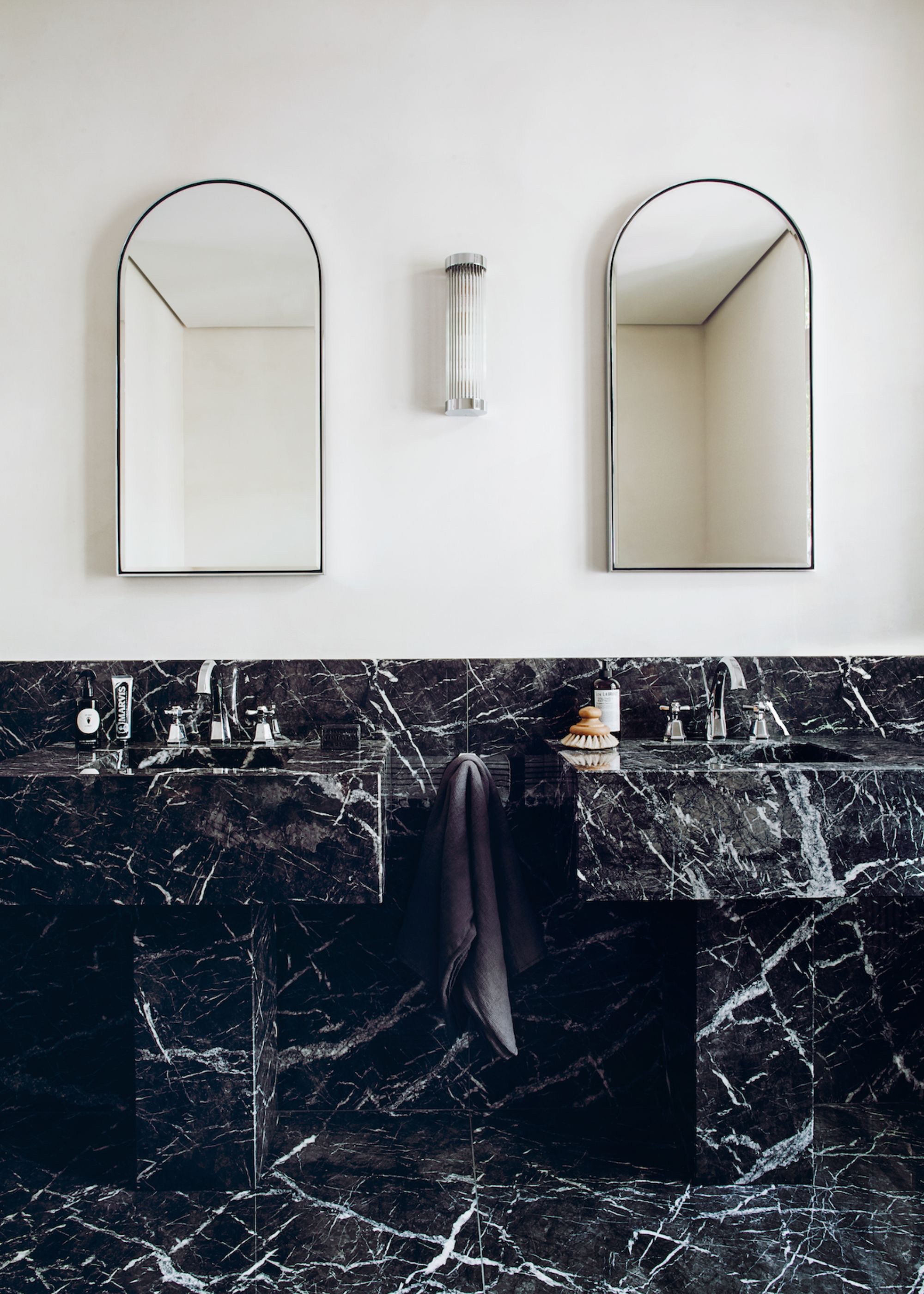
Boost the bathroom's aesthetics with marble used across the floor and sinks .
The good news? You don’t need a major makeover to achieve that designer look — marble bathrooms can do it for you. This timeless stone works beautifully in both classic, opulent settings and sleek, contemporary spaces, catering to a wide range of design preferences. While white marble bathroom tiles have long been a favorite among homeowners and designers alike, today’s trends are leaning toward darker stones — not only for their striking aesthetic but also for their practicality.
“Eager to mix old with new, we designed an extremely sleek bathroom of classical proportions, with a Grigio Carnico marble basin that continued onto the flooring,” say Guillaume Gibert and Baptiste Rischmann, founders of RMGB.
The dark color and bold veining help conceal dirt, marks, and even small cracks, making it a smart and stylish choice. Plus, it brings a distinctive character to the space — a sophisticated way to introduce color into the room.
For over a decade, Guillaume Gibert and Baptiste Rischmann have quietly built a reputation rooted in refinement and intention. As founders of RMGB, they let their thoughtful, understated work take center stage — each project a one-of-a-kind expression shaped by the needs of its inhabitants and the character of the space itself. Their creative partnership is defined by balance: while one brings a bold, expressive use of color, the other grounds the vision with precision and restraint.
2. Go for Bright, Colorful Tiles for a Dramatic Bathroom

Add oodles of fun to the bathroom with multicolored tiles, used across the room.
If you’re on the hunt for creative bathroom color ideas, this space by Another Human is a perfect example of bold, playful design.
The Livingetc newsletters are your inside source for what’s shaping interiors now - and what’s next. Discover trend forecasts, smart style ideas, and curated shopping inspiration that brings design to life. Subscribe today and stay ahead of the curve.
Why settle for paint when you can make a statement with bright, vivid tiles instead? Try creating a joyful palette of greens, blues, pinks, or any tones that speak to your style, and color-drench the room for an instant mood boost. This approach would work especially well in powder rooms or kids’ bathrooms, giving the space a fun, jewel-box feel.
“I selected the Daltile tiles in my bathroom because I love lime green and aqua blue together, and since it was my own bathroom, I could push the color palette into a more wild space than most clients would be interested in,” says Leah Ring, principal at Another Human. “I did a bit of a wider grout line to lean into the sort of retro feeling of the 4x4 tile.”

Leah Ring is the founder and principal of Another Human, an LA based interior design firm. Leah's approach to design is rule-breaking and eclectic, resulting in considered, layered interiors that are equally polished and playful.
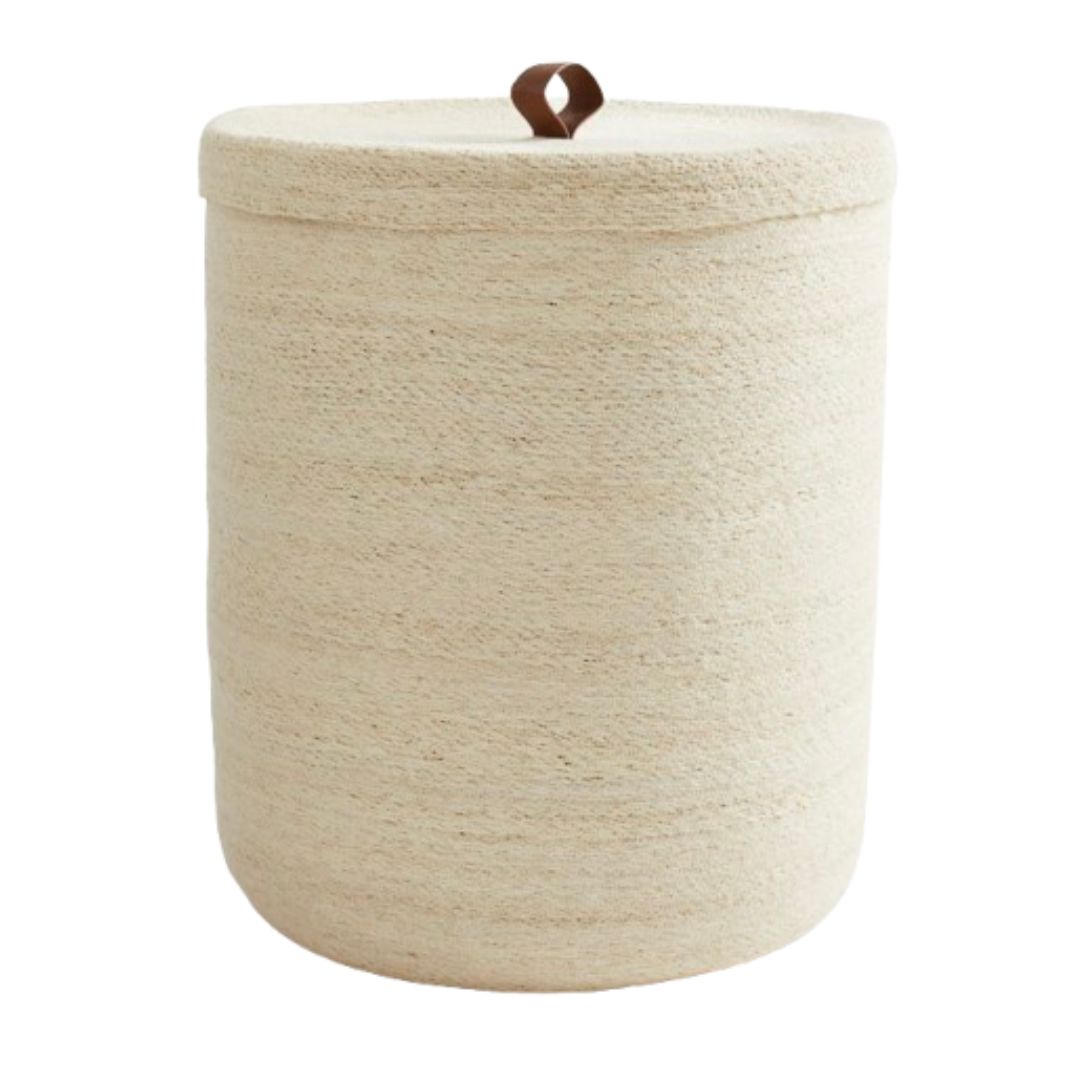
Crafted from natural woven seagrass, this laundry basket brings an earthy, textured charm to the bathroom. It features a coordinating lid to keep contents neatly tucked away, along with a sturdy handle made from coated fabric for easy lifting. It’s a perfect addition to your home.
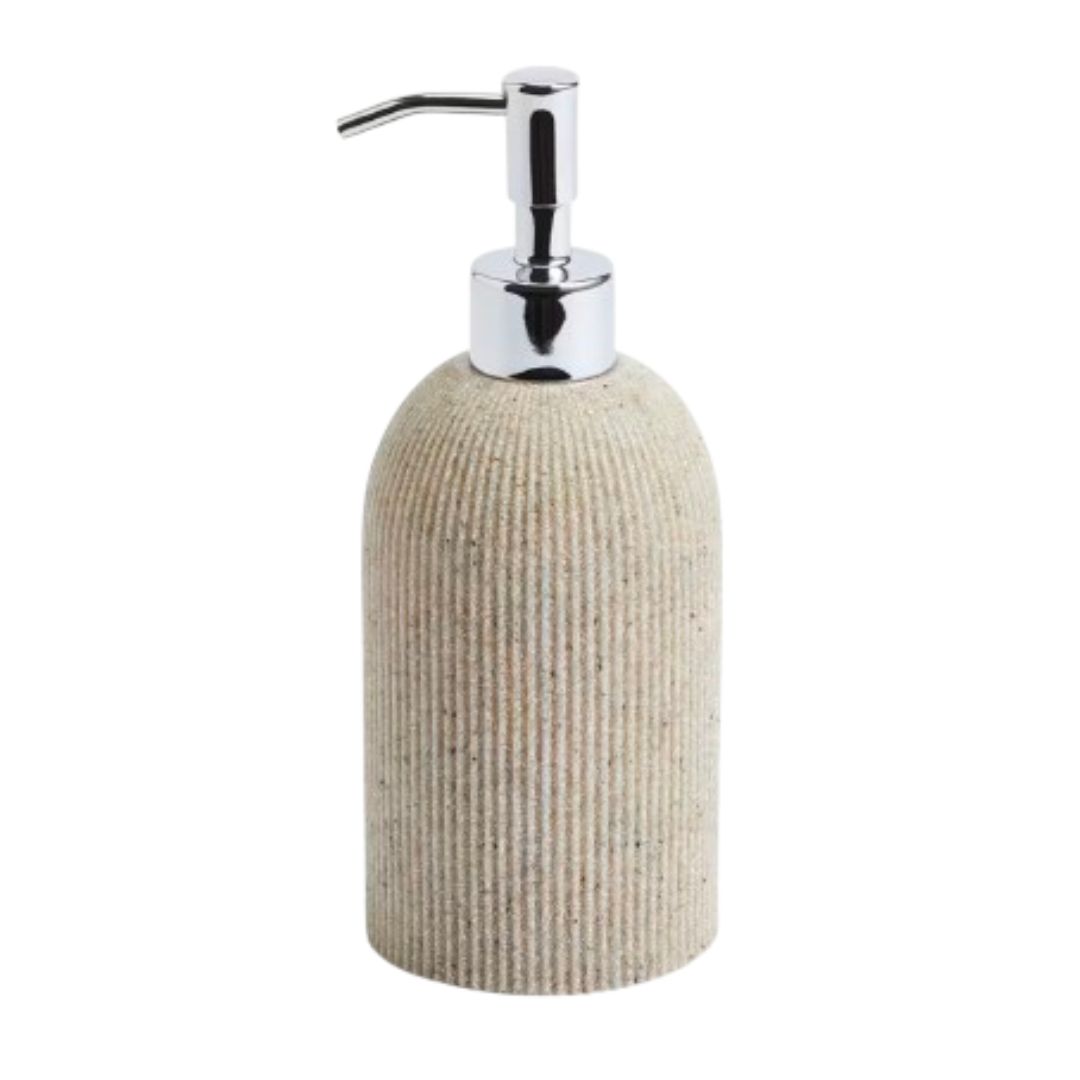
Add a touch of elegance to your bathroom with this chic soap dispenser. Featuring a natural stone-look finish and ridged texture, it’s both stylish and tactile. A polished chrome nozzle completes the modern, sophisticated design, making it a functional yet decorative addition.

Brighten up your bathroom with this cheerful daisy bath mat. Made from soft, tufted 100% cotton, it offers a non-slip, absorbent surface for stepping out of the bath or shower. Both practical and playful, it’s machine washable for easy care and adds a fun, cozy touch to your space.
3. Mix and Match Flooring Types for a More Functional Bathroom
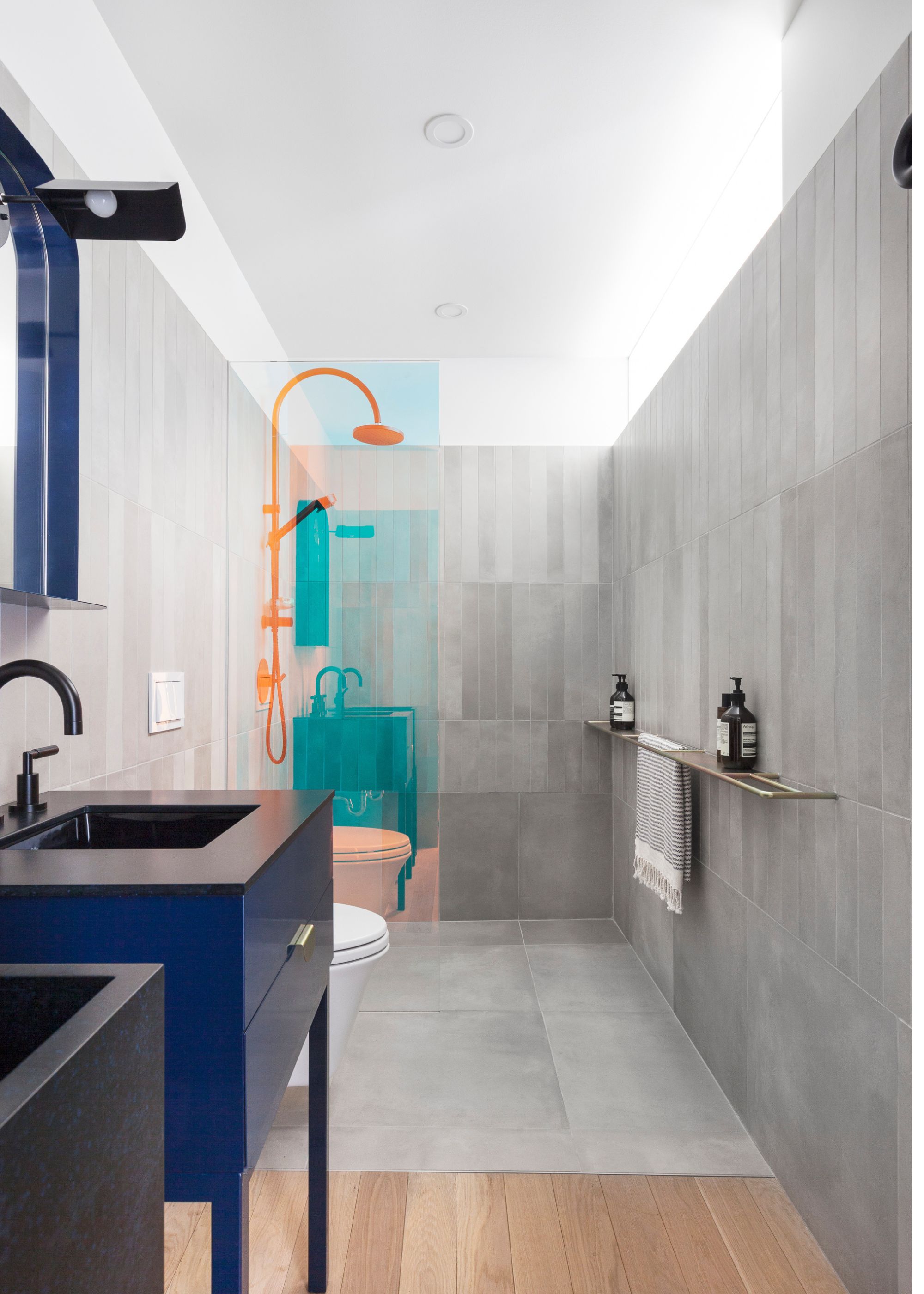
Go half-and-half with a concrete and wood bathroom.
A big bathroom flooring trend is to not rely on a single tile throughout the entire bathroom — in fact, it’s often more practical to choose different materials for the dry and wet zones.
Take this space by Nicholas Sangaré, founder of SANGARE, as an example. The combination of bathroom floor tiles adds visual depth while also making the space easier to use and maintain.
“We really like to choose materials based on their function,” says Sangaré. “In this case, it didn’t make sense to tile the entire floor. Plus, if we had, we would’ve needed to install underfloor heating, which would have added unnecessary costs to the project. So, we designed it in a way that lets us use hardwood flooring all the way up to the toilet, ensuring you can walk on warm floors most of the time. Tiles are only used in high-traffic areas where easy cleaning is essential.”

Nicholas Sangare resides and works in Montreal. In 2015, he co-founded the multidisciplinary design studio Ranville-Sangaré, now known as SANGARE. Since 2022, he has been striving with the studio to design spaces and objects while considering environmental issues and highlighting the expertise of the local industry. With the studio, he aims to establish professional relationships with companies related to well-being.
4. Choose Mosaic Flooring
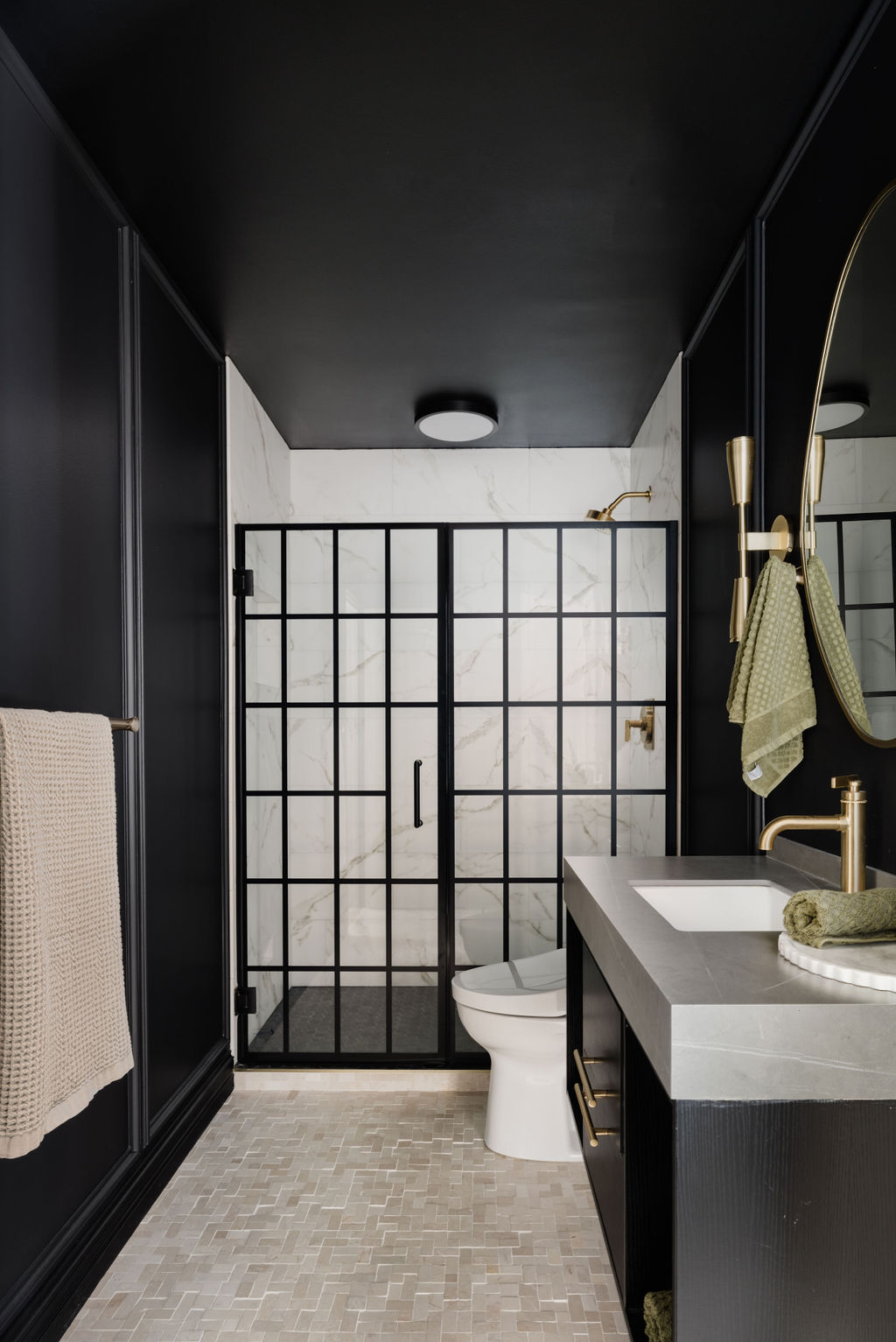
There's plenty of glamor packed in the tiny mosaic tiles.
Wondering if you can use mosaic tiles on the floor? Absolutely! Mosaics aren’t just timeless — they’re ageless. These tiny tiles can look incredibly pretty, though they do require a skilled hand to install. Regardless of the color palette you choose, mosaic tiles add pattern, texture, and depth to a bathroom.
“I chose a neutral, mosaic flooring to add a little texture to the space and contrast with the large-format tile in the shower and chunky slab vanity top,” says Laura Williams of Living Oak Interior Design. “This tile is made of natural stone and is a beautiful way to bring durability into the space.”

Laura Williams is the founder and principal designer of Living Oak Interior Design, a boutique firm based in Austin, Texas, along with its retail counterpart, Living Oak Home Decor — a store that reflects her design philosophy: sophisticated, yet approachable. Her work blends intentional functionality with timeless style, emphasizing natural elements, durable materials, and comfortable furnishings. At Living Oak Interior Design, the goal is simple: to create homes that feel just as good as they look.
5. Make a Statement with Micro-Mosaics
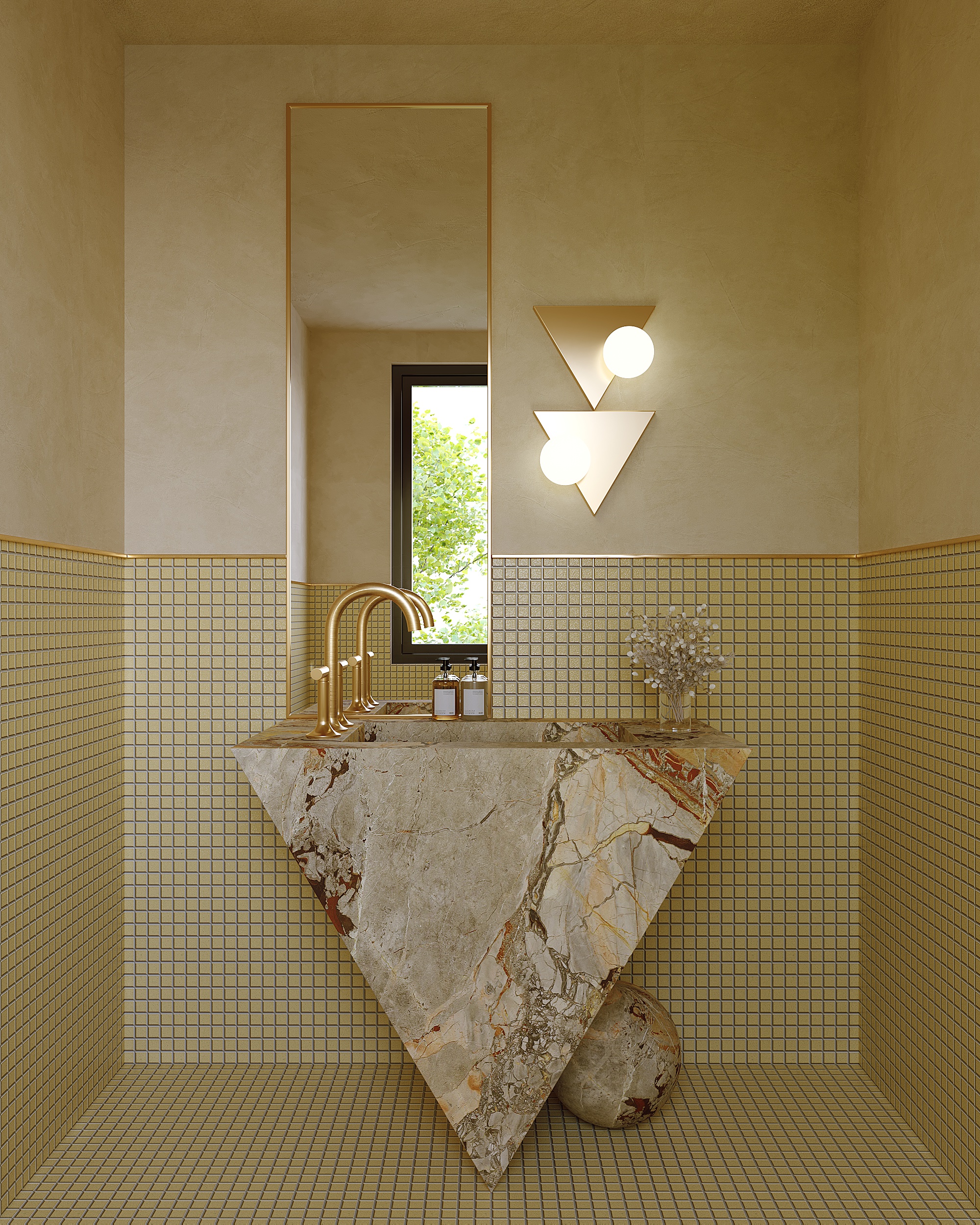
Add a sparkle with gold-finished tiles that give the bathroom a regal feel.
Adding an art mosaic or micro-mosaic can instantly create a calming, spa bathroom effect. In addition to their durability, mosaic tiles are incredibly versatile — offering endless possibilities when it comes to patterns, sizes, and color combinations.
“The main purpose of choosing this floor material was not to overshadow the bold triangular sink design,” says Ömer Özturk, founder of Ömer Özturk Interiors. “The sink has a strong presence due to its shape and marble material, so I wanted to go with a very flat and simple floor tile. Extending the tiles from the wall to the floor helped create contrast and an optical illusion between the geometries. I liked the variety created by combining the square tiles with the triangular sink. I love using different geometric shapes and forms together.”

Ömer Öztürk is a Turkish interior architect and designer based in Istanbul. He leads a multidisciplinary design studio where he works across a range of interior design projects and furniture collections. Passionate about creativity in all forms, Ömer thrives on designing, producing, and exploring the interplay of color and geometry in his work.
6. Add Charm to a Muted Bathroom With Vivid Tiles
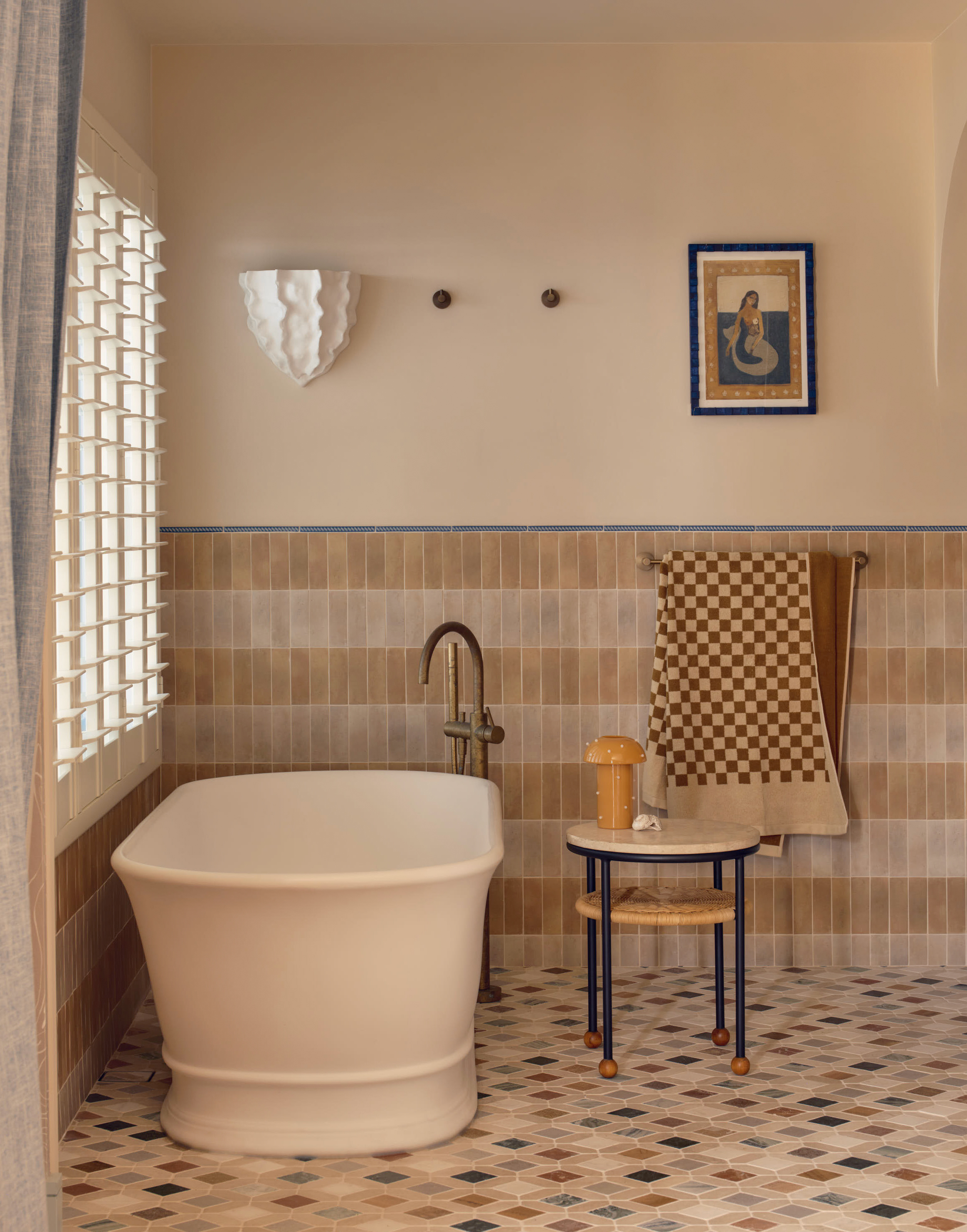
Choose multi-patterned tiles to give the bathroom depth.
Speaking of mosaics, marble mosaic tiles offer a wealth of benefits when it comes to interior design. For those looking to elevate their bathrooms with luxurious touches, marble remains a timeless choice that delivers both elegance and practicality. Whether used in a bathroom or elsewhere in the home, these tiles are a smart investment thanks to their durability and enduring appeal.
“The bathroom floor features a tumbled marble mosaic, where softly muted colors are scattered organically across a base of beige-toned tiles,” says designer Jono Fleming. “This mosaic approach adds visual interest without overwhelming the space, introducing pattern on pattern in a way that feels both playful and grounded. The overall palette remains calm and neutral, while subtle pops of earthy tones and a touch of navy in the side table provide moments of depth and contrast.”

Jono Fleming is an interior designer, stylist and writer based in Sydney. His husband Ryan McGregor is an interior designer working with Studio Pulp based in Sydney. They worked together on the Newport project as their first design collaboration.
7. Match the Bathroom Flooring With the Wallpaper
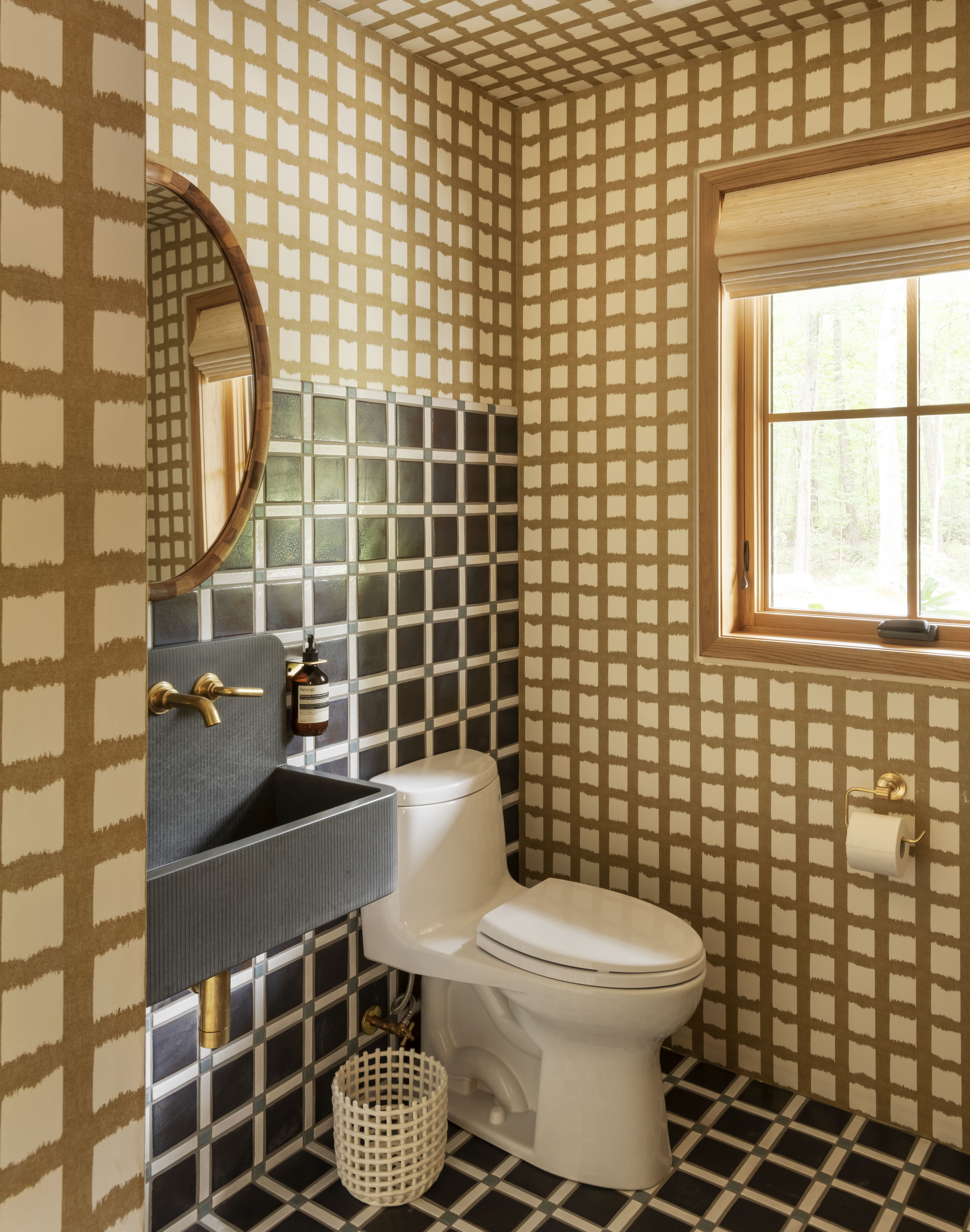
A bathroom with graphic wallpaper, and equally graphic floor tiles.
Go all out with a bathroom wallpaper, and tiles to match. This space by Victoria Sass, design director at Prospect Refuge is a great example.
“Choosing a unique wallpaper for your bathroom is one thing, but combining the perfect pattern with a custom tile, now we're talking!” she says. “I'm so in love with this over-the-top marriage of textures — it gives this teeny tiny space so much life.”
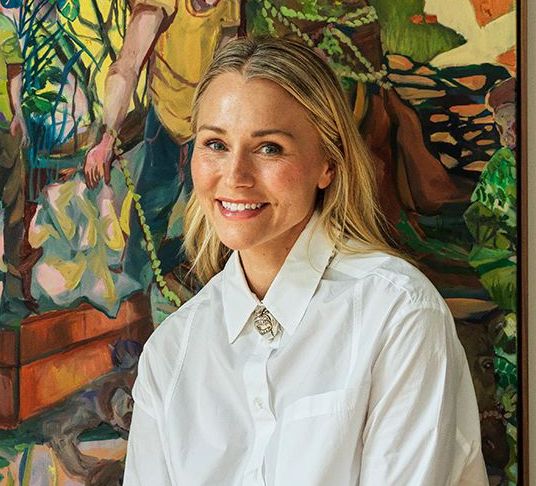
Victoria Sass is the founder of Prospect Refuge Studio and Gallery, known for her emotionally rich interiors that blend art, craft, and storytelling. Based in Minneapolis, she is a leading voice in reimagining Midwestern design for a global audience.
8. Make a Statement With Encaustic Cement Tiles
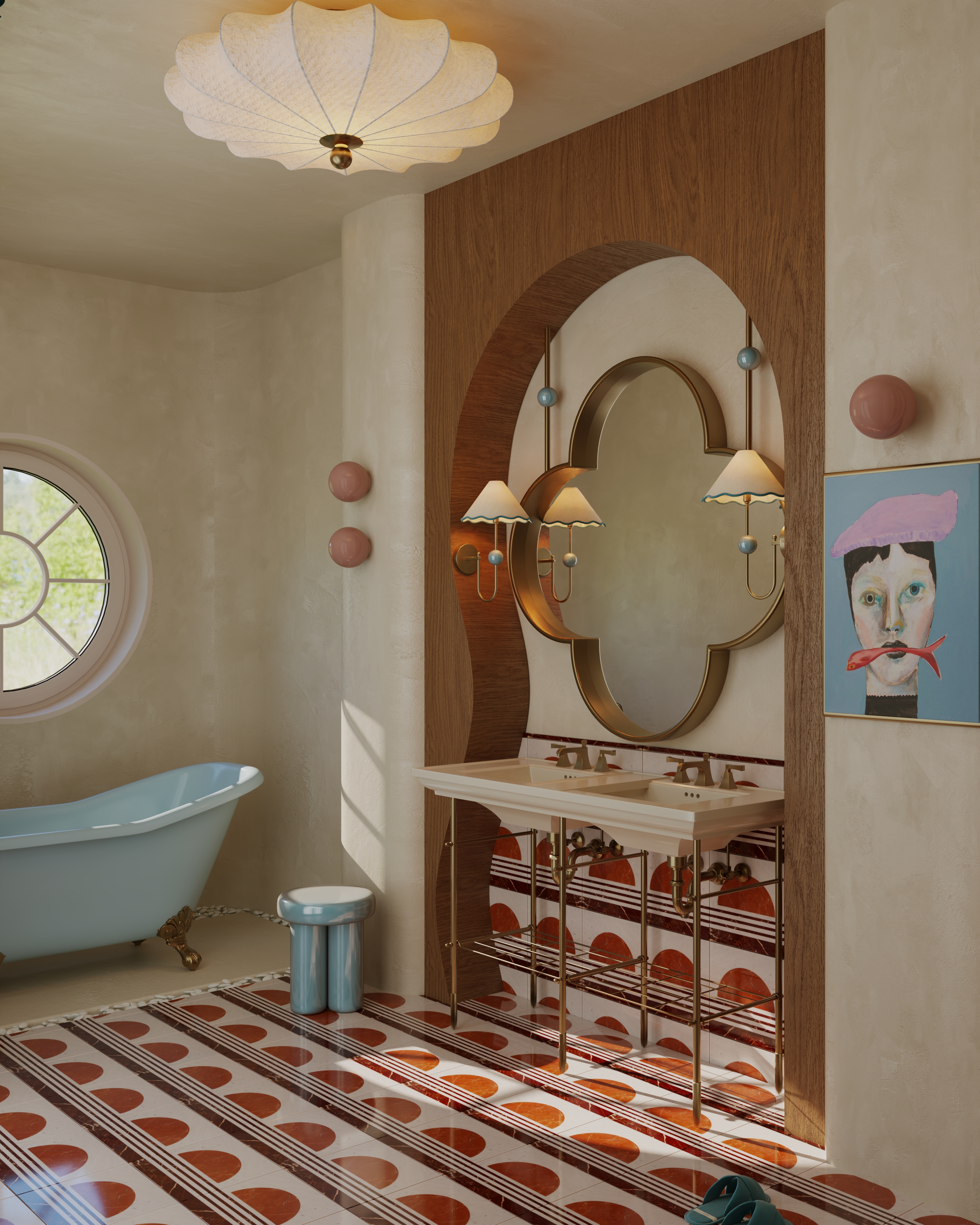
Lay out tiles in a carpet-like fashion.
What if you could have a carpet in the bathroom? Sounds unusual? Not if you're using tiles instead. One of the biggest bathroom tile trends right now is laying tiles in creative patterns and layouts — almost like a beautiful runner that flows from the sink across the floor and up the wall, as seen in this space designed by interior designer Rana Gunes.
She says: "In this bathroom design, I aimed to blend the tranquil and warm essence of the Mediterranean with contemporary aesthetics. Otto Tiles' sunset-inspired tiles, interpreting the mesmerizing color transitions of nature through a modern lens, became the focal point of the design. The warm tones used, especially in conjunction with the play of light in the bathroom, add depth and a dynamic atmosphere to the space. While drawing inspiration from the Mediterranean's unique texture, I made sure not to compromise on simplicity with the sharp lines of contemporary design. Each tile provides both a visual and emotional warmth."

Rana Gunes is an interior architect and designer based in Istanbul. Her work explores emotional forms to create intuitive connections between people and the spaces they inhabit.
9. Keep it Calm and Simple With Speckled Terrazzo Tiles

In a color-drenched bathroom, create balance with subtle terrazzo flooring.
Durable, hygienic, and visually striking, terrazzo is a standout choice for bathroom flooring. Not only is it stylish, but certain types of terrazzo are also resistant to microbial growth, making it a naturally more sanitary option that supports a healthier indoor environment.
In terms of bathroom tile costs, terrazzo is relatively affordable for a natural stone, starting at around £75 per square meter. For a custom, poured-in-place finish, prices can range from £400 to £600 per square meter.
Aesthetically, it’s hard to beat the mesmerizing, speckled finish of terrazzo, which adds depth and interest to a space, preventing it from feeling too flat. In this bathroom, the flooring provides a grounding contrast to the fully painted walls.
“We wanted a floor for this bathroom that would evoke the feeling of a beach,” say Petra Decouttere and Jan Baes of AE-architecten. “So we created a custom terrazzo mix designed to capture that mood. The walls are finished with green Mortex, which complements the flooring beautifully.”
AE-architecten, founded by Petra Decouttere and Jan Baes, is based in Gentbrugge, Belgium. The studio is driven by a broad interest in architecture with a strong focus on social relevance, primarily expressed through projects in housing, public spaces, and civic buildings.
10. Or Go for a Larger-Flecked Terrazzo
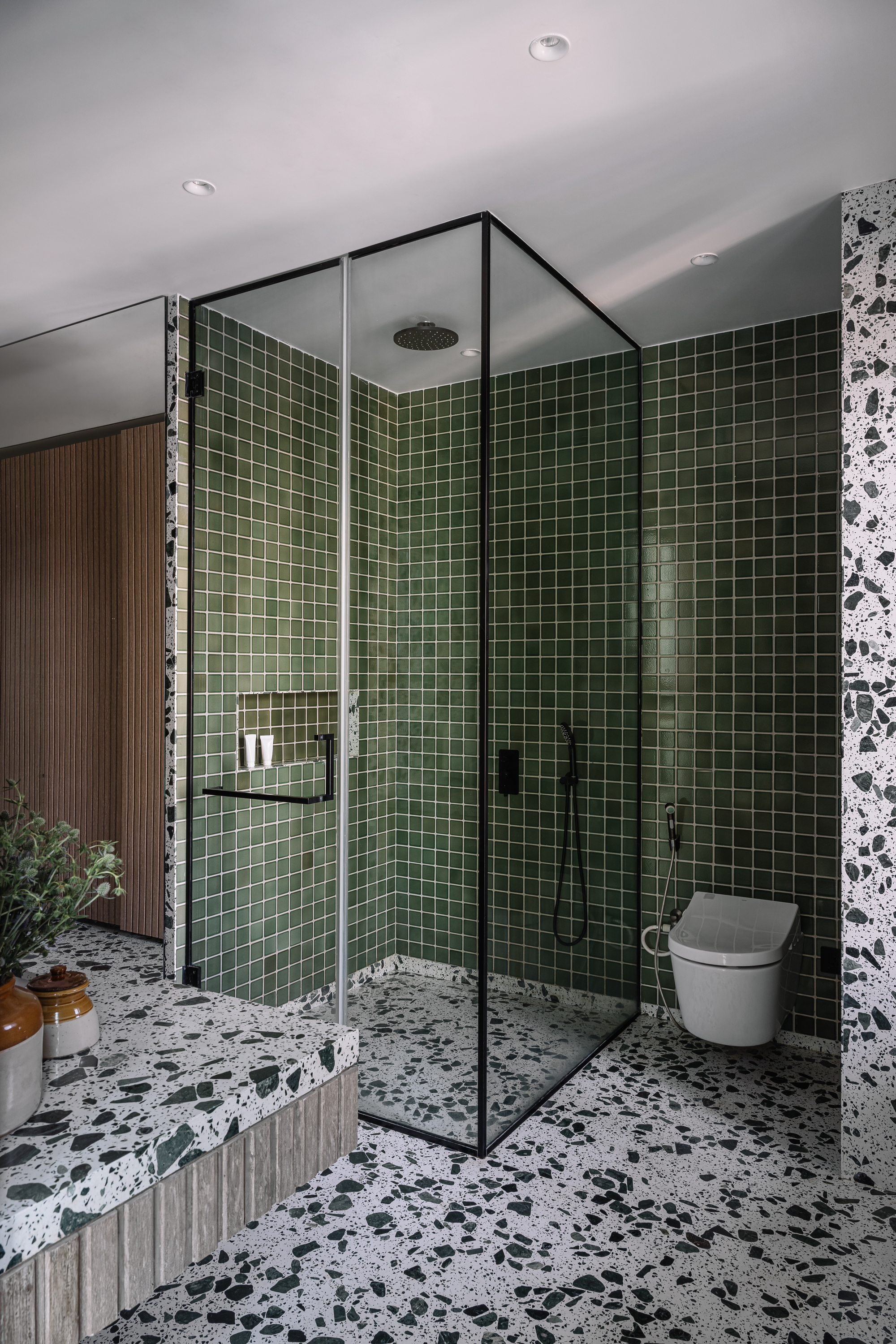
This bathroom by reD Architects makes a big impact with heavily-patterned marble.
Add drama and intrigue to your bathroom with heavily speckled terrazzo flooring. As it continues to rise in popularity, more budget-friendly alternatives have emerged — most notably, porcelain terrazzo tiles. These options mimic the look of real terrazzo, offering a hard-wearing and low-maintenance surface. Porcelain versions are typically created by scanning actual terrazzo and printing the image onto a porcelain base.
"The seamless yet versatile quality of terrazzo, in addition to its bold, striking pattern, which resonates with the green wall tile, makes it the obvious winner for the choice of flooring," says Maithili Raut, partner at reD Architects.

Maithili Raut's work encompasses a wide range of scales and typologies — from museums and institutional buildings to interiors for retail spaces, offices, and residences. She has also led the redevelopment of heritage structures and contributed extensively to urban design projects, including inner-city revitalization initiatives and long-term campus master plans for major Ivy League universities in the United States.
11. Ensure Practicality and Durability With Porcelain Tiles

Nothing is more durable than large-scale porcelain tiles.
Experts largely agree that porcelain and ceramic are considered the best bathroom flooring options. “Porcelain and ceramics historically tend to be the most durable, as they are hard-wearing and easy to maintain,” says Lindsay Olson, principal and founder of Lulu Designs.
Porcelain, in particular, absorbs less than 0.5% of moisture and is naturally dense, making it highly resistant to water and ideal for bathroom environments. Its density also makes it an excellent option for high-traffic areas, as it's less prone to wear and tear. Through-body porcelain — where the color runs throughout the entire tile, not just on the surface — is especially resistant to scratches, making it both a practical and long-lasting choice.

Lindsay Olson is the founder and principal designer of the California-based Lulu Designs. Her passion for design evolved over two decades from real estate to furniture design, ultimately leading her to establish her luxury interior design firm.
12. Add Dimension With Patterned Flooring
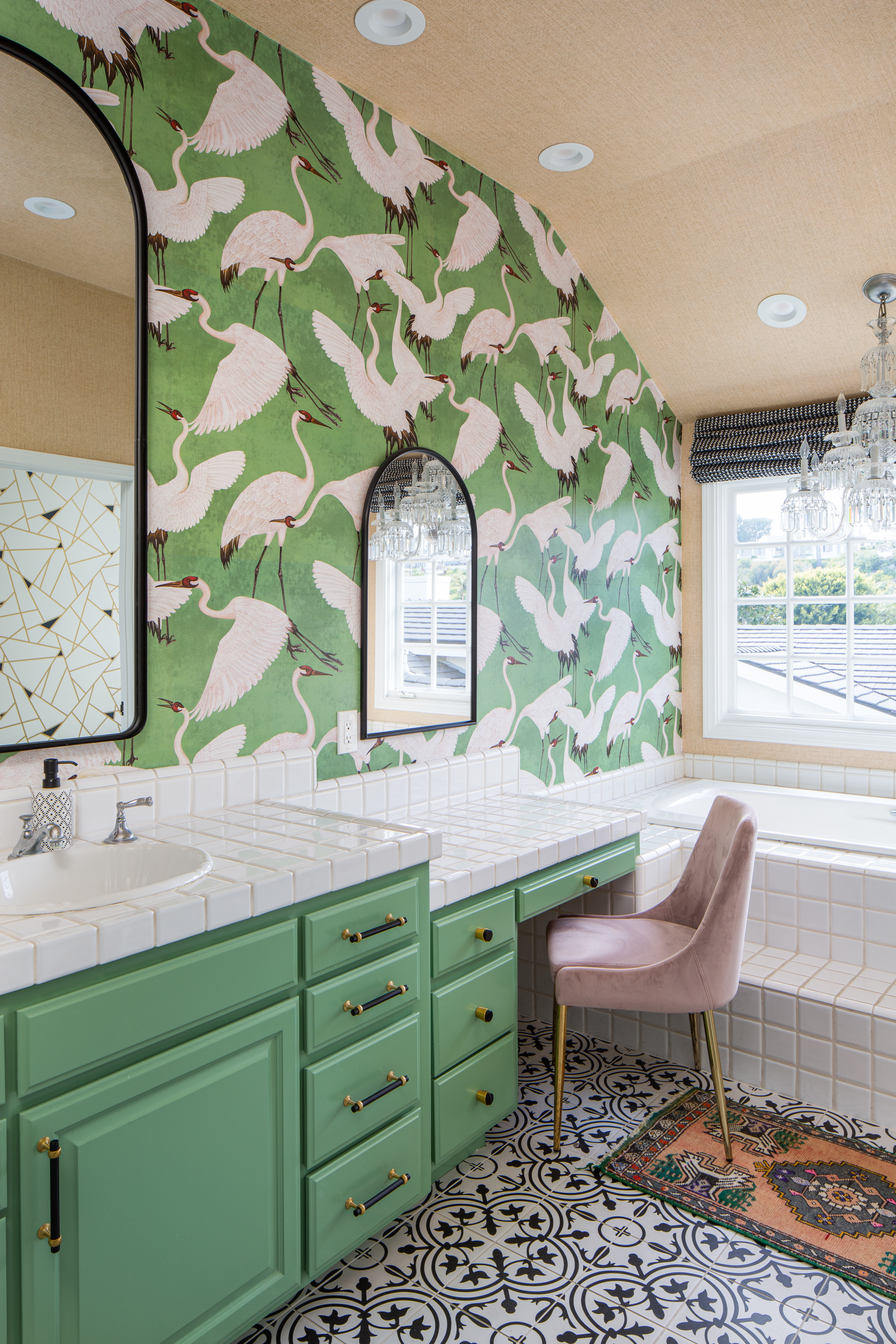
Give the bathroom movement with large, patterned tiles.
Wondering how to tile a bathroom in more interesting ways? One approach is to shift the entire focus to the flooring. Consider geometric, Aztec, or chevron patterns — these not only add a decorative touch but also create the illusion of a more spacious room.
Olson says, “In this bathroom, we used decorative porcelain. The pattern was chosen to add a fun element to an original 1960s classic beach home. The client wanted to give it a facelift while still keeping it playful and distinct from the original all-white tile used throughout.”
13. Opt for Wood for an Organic Vibe
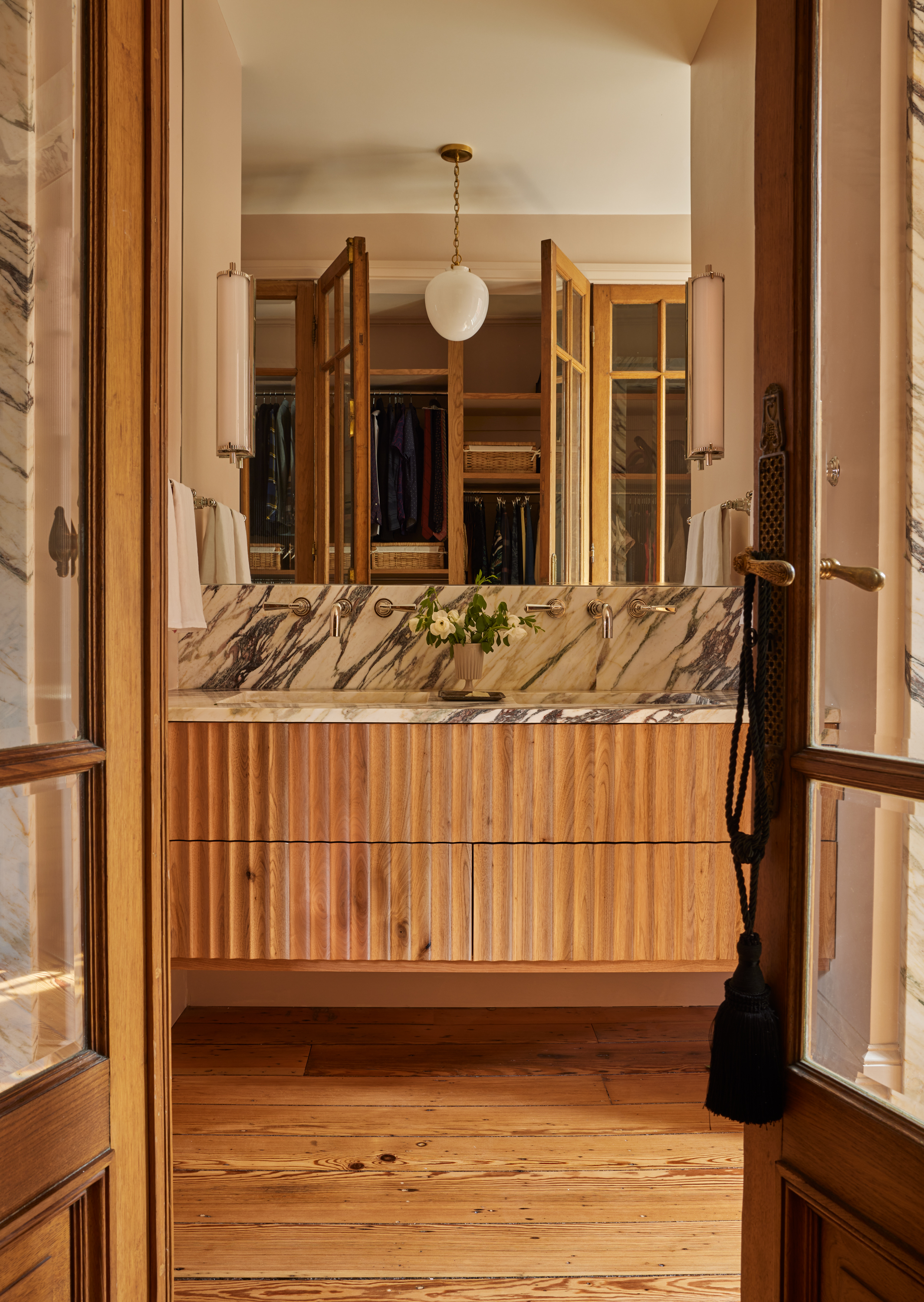
Wood planks as flooring will give the bathroom a spa-like feel.
Wood bathrooms? Yes, please! While tile has long been the go-to material for bathroom surfaces — and for good reason — tile and grout aren’t entirely immune to stains or cracking. That’s where the magic of wood comes in. The way it feels underfoot, the warmth it brings, and even the way it reflects light can transform the space. Wood adds natural color, depth, and softness, balancing out the harder finishes of ceramic or porcelain.
Natural softwood planks can create a stylish, eco-conscious look. Just keep in mind: bare wood is prone to staining, so sealing it with a water-based urethane will help preserve its grain and vibrancy. To complete the look, pair your flooring with wood cabinetry and storage in complementary tones for a layered, cohesive feel.
"When investing in hardwood flooring, one of the most critical factors to consider is its durability as it directly impacts how well the flooring can withstand daily wear and tear, foot traffic, moisture, and other environmental factors," says Aparna Kaushik, founder & architect of Aparna Kaushik Design Group.
Aparna Kaushik's body of work spans a wide spectrum of luxury lifestyle projects, each marked by a distinct blend of creativity and precision. Her design approach fuses experimentation with a clear, pragmatic vision, resulting in spaces that range from grand and expansive to elegantly intimate. Her portfolio includes a diverse array of projects, from private residences and commercial developments to retail spaces, restaurants, spas, and pubs.
14. Boost the Bathroom's Palette With Poured Microcement
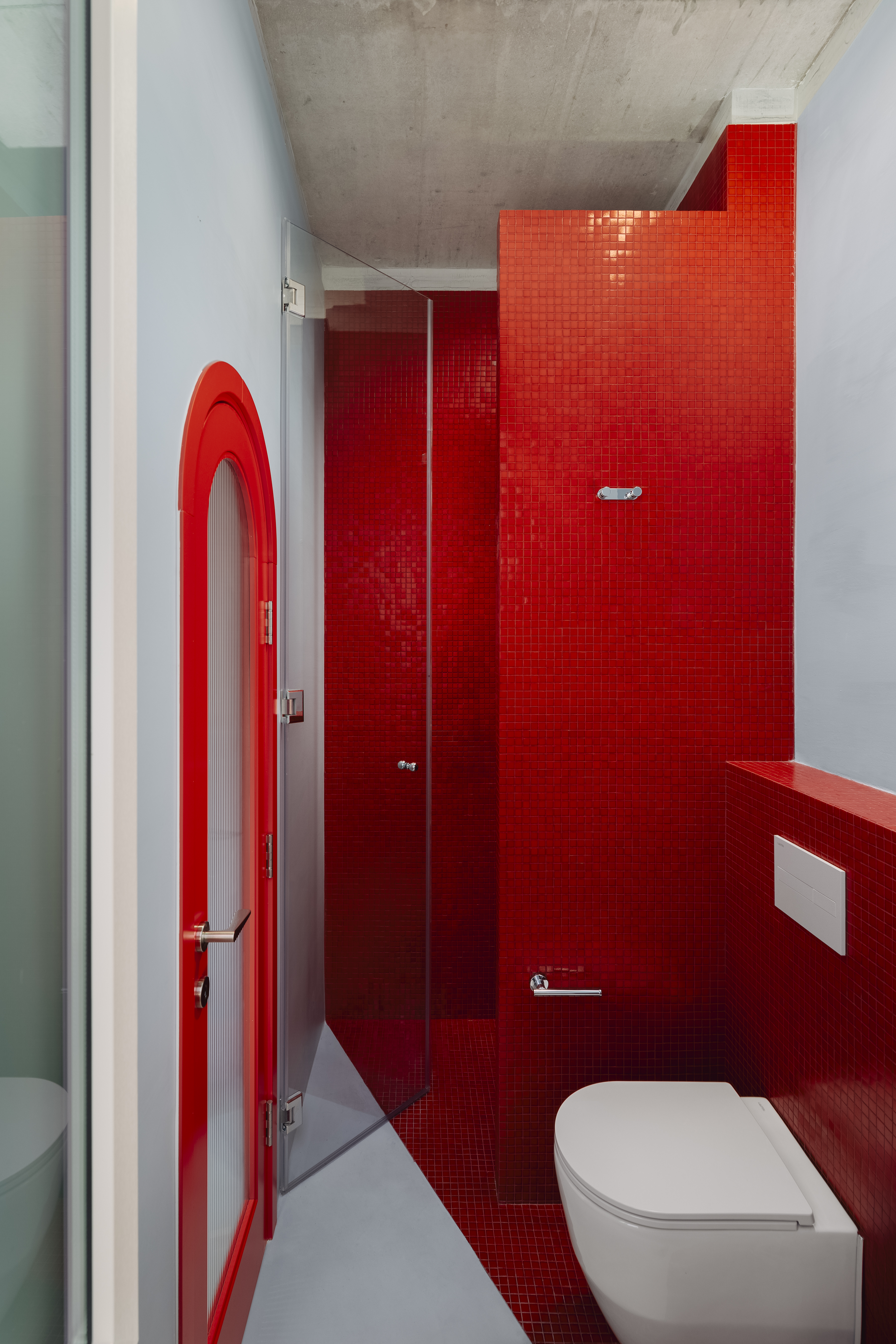
Inject personality into a small bathroom with stained tiles.
Give a small bathroom a big boost of personality with vivid flooring. Poured microcement floors are a great option — this finish is seamless, durable, and visually striking. It's particularly well-suited to bathrooms thanks to its resistance to water, stains, and wear in high-traffic areas.
“We used small red mosaic tiles on the walls and floor of the bathroom,” says Martina Fenech Adami, founder of Studio NiCHE. “The rest of the floor features a light blue and beige microcement finish.”

Martina Fenech Adami is a multidisciplinary interior designer and founder of studio NiCHE, a Malta-based practice exploring the intersection of materiality, memory, and spatial narrative. Her work reflects a deep sensitivity to context merging contemporary design with subtle cultural and emotional resonance.
15. Choose Groutless Bathroom Flooring for a Seamless Look
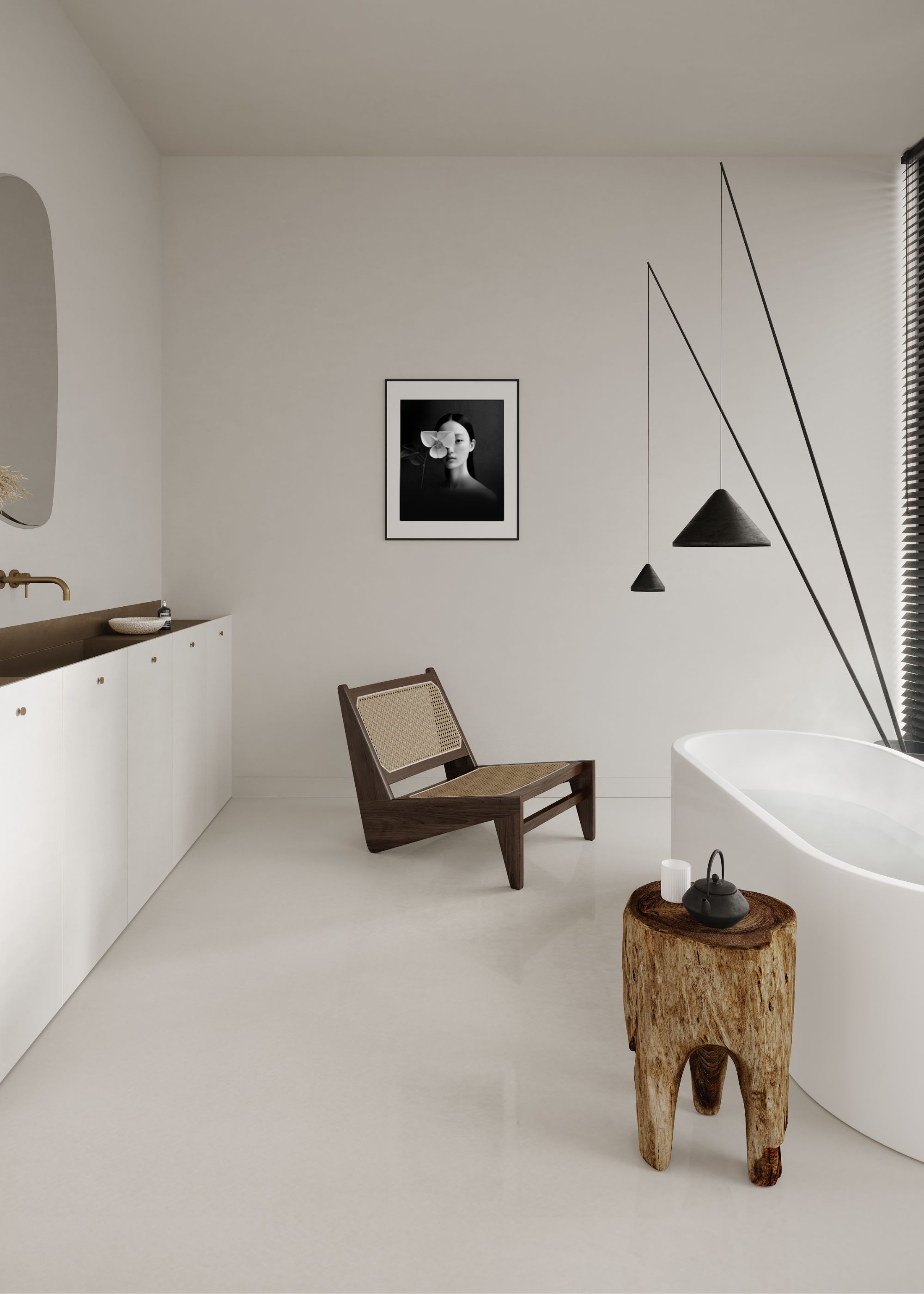
Keep it simple and seamless with polymer floors.
One of the best ways to make a small bathroom look bigger is by going groutless. Seamless, uninterrupted surfaces create the illusion of more space, making the room feel brighter and more open. Groutless finishes are also more hygienic, as they eliminate the grout lines where mold and mildew can accumulate, meaning less time spent on cleaning.
"Polymer floors are known for their durability, water resistance, and seamless finish," says Zakhar Zibrov of ZRIVERSTUDIO. "They’re a popular choice for wet areas like bathrooms because they create a smooth, non-porous surface that’s easy to clean and resistant to mold and mildew. Additionally, polymer flooring can be customized with various colors, patterns, and textures, making it both functional and aesthetically versatile, although we personally lean toward a monochrome approach."
Groutless surfaces are typically durable and resistant to moisture and wear. Many options, such as large-format porcelain or ceramic tiles, are waterproof, making them ideal for bathroom use. What’s more, groutless installations can sometimes be more cost-effective than traditional tiled setups.
ZRIVERSTUDIO is a Ukrainian design and architecture studio founded by Diana and Zakhar Zibrov. They create spaces for conscious living and explore the emotional connection between design and human experience. Since 2014, they've been creating private and commercial spaces across Ukraine, Europe, and the U.S.
From classic stone flooring like marble and terrazzo (whether lightly or heavily speckled) to tiles such as ceramic, porcelain, mosaic, and more — there are countless ways to bring life into your bathroom while ensuring it remains durable, low-maintenance, and timeless. And don’t forget — your bathroom flooring can also serve as the focal point of the space. Bright colors, bold patterns, or unexpected textures can transform the room and add a unique design statement.
FAQs
What Is the Best Flooring for a Bathroom?
Choosing the right bathroom flooring means balancing practicality with aesthetics. Among the top contenders, porcelain tile stands out for its sleek appearance, exceptional durability, and near-zero water absorption — perfect for wet areas. Vinyl tile is another smart pick, offering a softer, warmer feel underfoot, impressive water resistance, and a wide range of design options at an affordable price. For a clean, contemporary vibe, microcement delivers a seamless, grout-free surface that’s both modern and easy to care for.
What Is the Best Flooring for a Small Bathroom?
When choosing flooring for a small bathroom, it’s important to prioritize both visual space and functionality. Ceramic tile is a great option — it's cost-effective, easy to clean, and comes in a wide variety of colors and patterns that can visually open up a room. To add character to the small space, you can also consider terrazzo as it brings a speckled, stylish look that adds pattern without overwhelming the room.
What Is the Best Way to Pick Bathroom Flooring?
Begin by assessing the bathroom’s moisture exposure — since it’s a high-humidity environment, opt for materials that are water-resistant, durable, slip-resistant, and easy to clean. Options like ceramic, microcement, luxury vinyl, and porcelain are all excellent choices.
Consider the room’s size as well; light-colored, large-format, or seamless flooring can visually expand smaller spaces. Your lifestyle also plays a role — if comfort is a priority, vinyl or wood-look alternatives offer a softer feel underfoot. Visually, your flooring should either harmonize with or add contrast to the rest of the room, including walls and fixtures. For a bold design statement, don’t shy away from vibrant patterns or textured tiles.

Aditi Sharma Maheshwari started her career at The Address (The Times of India), a tabloid on interiors and art. She wrote profiles of Indian artists, designers, and architects, and covered inspiring houses and commercial properties. After four years, she moved to ELLE DECOR as a senior features writer, where she contributed to the magazine and website, and also worked alongside the events team on India Design ID — the brand’s 10-day, annual design show. She wrote across topics: from designer interviews, and house tours, to new product launches, shopping pages, and reviews. After three years, she was hired as the senior editor at Houzz. The website content focused on practical advice on decorating the home and making design feel more approachable. She created fresh series on budget buys, design hacks, and DIYs, all backed with expert advice. Equipped with sizable knowledge of the industry and with a good network, she moved to Architectural Digest (Conde Nast) as the digital editor. The publication's focus was on high-end design, and her content highlighted A-listers, starchitects, and high-concept products, all customized for an audience that loves and invests in luxury. After a two-year stint, she moved to the UK and was hired at Livingetc as a design editor. She now freelances for a variety of interiors publications.